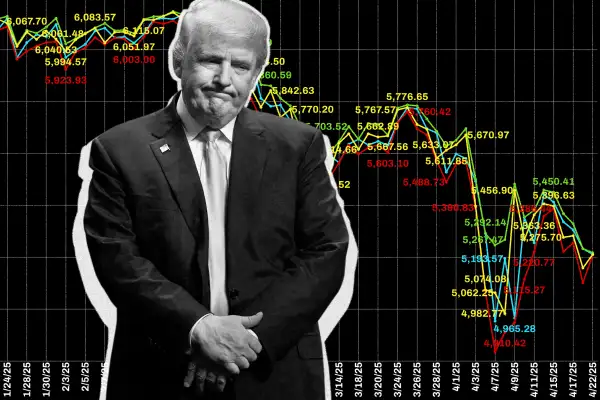After 100 Days in Office, the Stock Market's 'Trump Bump' Has Become a Trump Slump
Money is not a client of any investment adviser featured on this page. The information provided on this page is for educational purposes only and is not intended as investment advice. Money does not offer advisory services.

When Donald Trump won the presidential election last November, the markets reacted positively. His deregulatory platform and perceived business acumen translated into strong performances across the board, propelling stocks into the new year.
From the election through Jan. 21, when the markets reopened after Inauguration Day, the Dow Jones Industrial Average gained 5.34%, S&P 500 gained 5.9%, and the Nasdaq gained 8.67%. The so-called "Trump bump" was grabbing headlines and appeared to be giving the bull market — which began in late 2022 — staying power.
But that rally proved to be short-lived. After his first 100 days in office, a dramatic shift in market narrative has occurred, and all post-election gains have been reversed. At press time Monday, all three of the major indices were lower than they were at any point between Election Day and the start of the president's second term. Meanwhile, market volatility has registered a five-year high, GDP forecasts and the value of the U.S. dollar have plummeted, and bearish consumer sentiment has surged alongside concerns about a looming recession.
As investors continue waiting for the president to fulfill his promise of an economic "boom like no other," here's how the Trump bump devolved into the Trump slump.
Tariffs tanked the markets
Last week, the Wall Street Journal reported that the S&P 500's performance since Inauguration Day was the worst for any president up to that point going back to 1928. The Journal also reported that the index was on track for its worst April — a month that historically sees strong stock performances — since 1932.
After the S&P 500 hit its all-time high on Feb. 19, the index went on to lose 10.13% through March 13 in anticipation of Trump's tariff announcement. Then, after a brief gain, those losses accelerated in the beginning of April.
As the markets remain rife with uncertainty, investors may want to start looking down the road, according to Chip Rewey, chief investment officer at Rewey Asset Management, a New Jersey-based registered investment advisor.
"I would encourage investors to lengthen their time horizons, which can make this whole tariff battle a little easier," he says. "Day to day, you are at the whim of a tweet."
An example of that capriciousness in messaging was on full display when the president formally announced his expanded tariffs on April 2. The market's reaction to Trump's self-proclaimed Liberation Day was extreme: From April 3 to April 4, a record-setting two-day sell-off wiped out $6.6 trillion of investor value. Then, on April 9, Trump walked back his plan by announcing a 90-day pause for new tariffs (with the exception of those levied against China), causing a momentary surge in equities.
The reprieves in downward prices seen over the past two months have proven to be insufficient in offsetting the initial losses incurred. According to fintech data platform Unusual Whales, the Dow has fallen by 1,000 points in a single day 11 times in history. Four of them have occurred since Trump's Liberation Day tariff announcements.
By contrast, since he took office in 2025, there has only been one day that the Dow gained 1,000 points.
In March, when addressing how the tariffs could impact stocks, the president said, "I'm not even looking at the market, because long term the United States will be very strong with what is happening here."
However, in the aftermath of the record sell-off, Trump attempted to reassure investors on April 6, saying, "I don't want anything to go down, but sometimes you have to take medicine to fix something."
The 90-day tariff pause is further contributing to an already clouded outlook. The American Association of Individual Investors' sentiment survey shows that bullishness has now been below its historical average for 15 out of the past 17 weeks, while bearish sentiment has increased 101.66% since Trump won the election.
Meanwhile, numerous Wall Street firms have recently downgraded their year-end price targets for the S&P 500, citing uncertainty about tariffs, subsequent inflation and potential economic contraction. Investment bank and financial services firm Jefferies, for example, cut its S&P forecast to 5,300 from 6,000. That's 3.4% lower than where the index sits today. (Historically, the S&P grows by an average of 10% annually.)
With the president's actions being magnified, investors are searching for cause and effect.
"The markets have become very short-term focused," Rewey says. "But the long term is a series of short terms, and what we're seeing now is how the sausage is made."
Fed attacks fuel uncertainty
Tariffs alone are not responsible for elevated investor fears and a downward price trend. The president's words carry tremendous weight, as was demonstrated last week when he lashed out at Federal Reserve Chairman Jerome Powell on social media.
On April 21, an additional $1.4 trillion was wiped out from the market as Trump took to Truth Social to criticize Powell, whom the president nominated in 2017, stating that he was in favor of the chairman being removed from his post before his term ends in 2026.
The social media post riled the markets. The major indices buckled under selling pressure with investors fleeing U.S. assets as Trump again pushed for the Fed to cut interest rates amid an already weakened U.S. dollar and subsequently climbing Treasury rates.
The president's attempts to pressure the Fed's monetary policy saw the S&P 500 fall by nearly 3% on April 21. But in the wake of the market's reaction, Trump again walked back his statements. Tuesday, the president softened his tone, telling reporters he had "no intention" of firing the Fed chairman despite reports that White House was looking into legal options to do so. Stocks rebounded in response, but again the initial market damage has outweighed the recovery.
The emerging pattern of threats and ensuing retractions have fueled uncertainty and negative sentiment — something Rewey directly links to the current market correction.
"When [Trump] has introduced so much uncertainty in the short term," he says, "I think the market has gone down because of that."
Expect more muddled markets
Because of current uncertainty, the market's correction and any potential timeline for recovery are difficult to gauge against other historic instances.
"This is self-inflicted," Rewey says. "In that sense, it's different than the COVID crisis or from the 2007-2009 financial crisis. Because this can be undone with backtracking."
But in the absence of clarity, the fallout from Trump's tariffs and his lambasting of Powell have resulted in fallout that has led economists to adjust the likelihood of a recession this year. Torsten Sløk, chief economist at Apollo Global Management, has stated that the probability of a self-induced voluntary trade reset recession, or VTRR, now stands at 90%.
According to Sløk, overnight tariffs will have an outsized adverse impact on small businesses, which presently account for more than 80% of U.S. employment.
In a post on the company's website, Sløk wrote that although "the administration inherited an economy with strong growth, 4% unemployment, positive hiring and a substantial tailwind from investments ... expect ships to sit offshore, orders to be canceled and well-run generational retailers to file for bankruptcy."
He also pointed to eight factors that, if not addressed, will continue presenting headwinds for the U.S. economy. Among them are higher tariffs, uncertainty about their permanence, retaliatory tariffs, lower tourism, lower consumer confidence and lower corporate confidence.
Sløk is not alone in his downward revision. The International Monetary Fund now forecasts the U.S. economy will grow just 1.8% this year, down 0.9% from its pre-tariffs estimate. As these impacts are realized, they could trickle down into the equities market leading to additional volatility and ongoing bearish price action.
Because of the unpredictability of Trump's messaging, Rewey believes that investors will be subject to a wait-and-see approach before understanding how anything develops.
"Time will bring clarity," he says. "Be willing to commit capital opportunistically to those long-term ideas, and make time your investment ally. Don't be a victim of the short term."
More from Money:
S&P 500, Nasdaq Display Ominous 'Death Cross' Patterns
'Anything Works in a Bull Market.' But What About a Bear Market?
Can Skipping Avocado Toast and Lattes Really Help You Buy a House?




